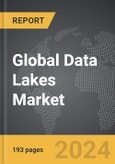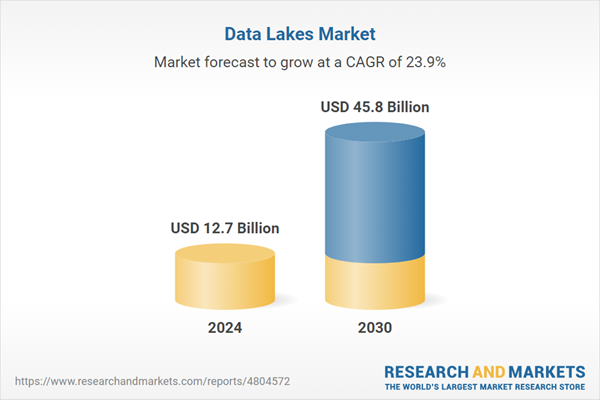The global market for Data Lakes was valued at US$12.7 Billion in 2024 and is projected to reach US$45.8 Billion by 2030, growing at a CAGR of 23.9% from 2024 to 2030. This comprehensive report provides an in-depth analysis of market trends, drivers, and forecasts, helping you make informed business decisions. The report includes the most recent global tariff developments and how they impact the Data Lakes market.
Segments: Component (Solutions, Services); Deployment (Cloud, On-Premise); Vertical (BFSI, IT & Telecom, Retail & eCommerce, Healthcare & Life Sciences, Manufacturing, Government, Other Verticals).
Geographic Regions/Countries: World; United States; Canada; Japan; China; Europe (France; Germany; Italy; United Kingdom; and Rest of Europe); Asia-Pacific; Rest of World.
The analysts continuously track trade developments worldwide, drawing insights from leading global economists and over 200 industry and policy institutions, including think tanks, trade organizations, and national economic advisory bodies. This intelligence is integrated into forecasting models to provide timely, data-driven analysis of emerging risks and opportunities.
Global Data Lakes Market - Key Trends and Drivers Summarized
What Are Data Lakes and How Do They Revolutionize Data Management?
Data lakes are centralized repositories designed to store, process, and secure large volumes of structured and unstructured data in their native format. Unlike traditional data warehouses, which store data in hierarchies and tables, data lakes employ a flat architecture where data is tagged with a unique identifier and metadata. This setup allows for greater flexibility and scalability, accommodating data from diverse sources such as social media, IoT devices, and transactional systems without the need for extensive preprocessing. The ability of data lakes to hold vast amounts of raw data presents significant opportunities for businesses to leverage big data analytics, thereby gaining deeper insights into customer behavior, operational efficiency, and market trends. This approach not only enhances decision-making but also fosters innovation by providing a broad canvas for data scientists and analysts to explore and experiment with data.How Do Data Lakes Facilitate Advanced Analytics and Business Intelligence?
Data lakes are integral to supporting advanced analytics and business intelligence due to their ability to handle diverse datasets at scale. By storing data in its raw form, data lakes enable organizations to apply various types of analytics - from real-time analytics to machine learning and predictive modeling - without the constraints of data silos and schema rigidity found in traditional databases. The architecture of data lakes allows for high-speed data ingestion and retrieval, which is crucial for dynamic analytics applications that require immediate insights to inform business decisions. Additionally, data lakes support the democratization of data within an organization. By providing broad access to data across different business units, employees can generate personalized reports and visualizations, enhancing transparency and collaborative decision-making.What Are the Challenges and Considerations in Implementing a Data Lake?
While data lakes offer substantial benefits, their implementation comes with significant challenges that organizations must navigate. One of the foremost concerns is data governance and security. The vast size and scope of data lakes make them vulnerable to security breaches and data leaks. Without stringent governance policies and robust security measures, data lakes can quickly become data swamps - disorganized and difficult to manage. Another challenge lies in ensuring data quality and consistency. Data lakes accept data in its native format, which can lead to issues of data redundancy, inconsistency, and incompleteness. Managing these aspects requires sophisticated data management tools and processes, as well as ongoing maintenance to prevent data decay. Furthermore, deriving value from a data lake requires specialized skills in data science and analytics, as extracting insights from large, diverse datasets is not trivial.What Drives the Growth in the Data Lakes Market?
The growth in the data lakes market is driven by several factors, underpinned by the increasing volume and variety of data generated by modern businesses. As organizations continue to undergo digital transformation, the need for flexible, scalable solutions to store and analyze data becomes critical. Data lakes are well-suited to meet this need, offering a platform that can handle the complexities of big data while supporting a wide range of analytical tools and applications. The rising adoption of cloud-based solutions also contributes to the growth of data lakes, as cloud platforms provide the necessary infrastructure to build and scale data lakes cost-effectively. Additionally, the push towards data-driven decision-making across industries propels the demand for data lakes, as businesses seek comprehensive insights that can drive strategic initiatives and competitive advantage. Economic factors, technological advancements, and sector-specific demands for improved data analytics capabilities further stimulate the expansion of the data lakes market, making it a cornerstone of enterprise data strategies.Report Scope
The report analyzes the Data Lakes market, presented in terms of units. The analysis covers the key segments and geographic regions outlined below.Segments: Component (Solutions, Services); Deployment (Cloud, On-Premise); Vertical (BFSI, IT & Telecom, Retail & eCommerce, Healthcare & Life Sciences, Manufacturing, Government, Other Verticals).
Geographic Regions/Countries: World; United States; Canada; Japan; China; Europe (France; Germany; Italy; United Kingdom; and Rest of Europe); Asia-Pacific; Rest of World.
Key Insights:
- Market Growth: Understand the significant growth trajectory of the Data Lakes Solutions segment, which is expected to reach US$25.9 Billion by 2030 with a CAGR of a 22.8%. The Data Lakes Services segment is also set to grow at 25.4% CAGR over the analysis period.
- Regional Analysis: Gain insights into the U.S. market, valued at $3.5 Billion in 2024, and China, forecasted to grow at an impressive 22.7% CAGR to reach $6.9 Billion by 2030. Discover growth trends in other key regions, including Japan, Canada, Germany, and the Asia-Pacific.
Why You Should Buy This Report:
- Detailed Market Analysis: Access a thorough analysis of the Global Data Lakes Market, covering all major geographic regions and market segments.
- Competitive Insights: Get an overview of the competitive landscape, including the market presence of major players across different geographies.
- Future Trends and Drivers: Understand the key trends and drivers shaping the future of the Global Data Lakes Market.
- Actionable Insights: Benefit from actionable insights that can help you identify new revenue opportunities and make strategic business decisions.
Key Questions Answered:
- How is the Global Data Lakes Market expected to evolve by 2030?
- What are the main drivers and restraints affecting the market?
- Which market segments will grow the most over the forecast period?
- How will market shares for different regions and segments change by 2030?
- Who are the leading players in the market, and what are their prospects?
Report Features:
- Comprehensive Market Data: Independent analysis of annual sales and market forecasts in US$ Million from 2024 to 2030.
- In-Depth Regional Analysis: Detailed insights into key markets, including the U.S., China, Japan, Canada, Europe, Asia-Pacific, Latin America, Middle East, and Africa.
- Company Profiles: Coverage of players such as Atos SE, Capgemini SE, Denodo, EMC Corporation, Hitachi Data Systems Corporation and more.
- Complimentary Updates: Receive free report updates for one year to keep you informed of the latest market developments.
Some of the 44 companies featured in this Data Lakes market report include:
- Atos SE
- Capgemini SE
- Denodo
- EMC Corporation
- Hitachi Data Systems Corporation
- IBM Corporation
- Informatica LLC
- Microsoft Corporation
- Oracle Corporation
- SAP SE
- SAS Institute, Inc.
- Talend
- Teradata Corporation
Tariff Impact Analysis: Key Insights for 2025
Global tariff negotiations across 180+ countries are reshaping supply chains, costs, and competitiveness. This report reflects the latest developments as of April 2025 and incorporates forward-looking insights into the market outlook.The analysts continuously track trade developments worldwide, drawing insights from leading global economists and over 200 industry and policy institutions, including think tanks, trade organizations, and national economic advisory bodies. This intelligence is integrated into forecasting models to provide timely, data-driven analysis of emerging risks and opportunities.
What’s Included in This Edition:
- Tariff-adjusted market forecasts by region and segment
- Analysis of cost and supply chain implications by sourcing and trade exposure
- Strategic insights into geographic shifts
Buyers receive a free July 2025 update with:
- Finalized tariff impacts and new trade agreement effects
- Updated projections reflecting global sourcing and cost shifts
- Expanded country-specific coverage across the industry
Table of Contents
I. METHODOLOGYII. EXECUTIVE SUMMARY2. FOCUS ON SELECT PLAYERSIII. MARKET ANALYSISIV. COMPETITION
1. MARKET OVERVIEW
3. MARKET TRENDS & DRIVERS
4. GLOBAL MARKET PERSPECTIVE
UNITED STATES
CANADA
JAPAN
CHINA
EUROPE
FRANCE
GERMANY
ITALY
UNITED KINGDOM
REST OF EUROPE
ASIA-PACIFIC
REST OF WORLD
Companies Mentioned (Partial List)
A selection of companies mentioned in this report includes, but is not limited to:
- Atos SE
- Capgemini SE
- Denodo
- EMC Corporation
- Hitachi Data Systems Corporation
- IBM Corporation
- Informatica LLC
- Microsoft Corporation
- Oracle Corporation
- SAP SE
- SAS Institute, Inc.
- Talend
- Teradata Corporation
Table Information
| Report Attribute | Details |
|---|---|
| No. of Pages | 193 |
| Published | April 2025 |
| Forecast Period | 2024 - 2030 |
| Estimated Market Value ( USD | $ 12.7 Billion |
| Forecasted Market Value ( USD | $ 45.8 Billion |
| Compound Annual Growth Rate | 23.9% |
| Regions Covered | Global |









